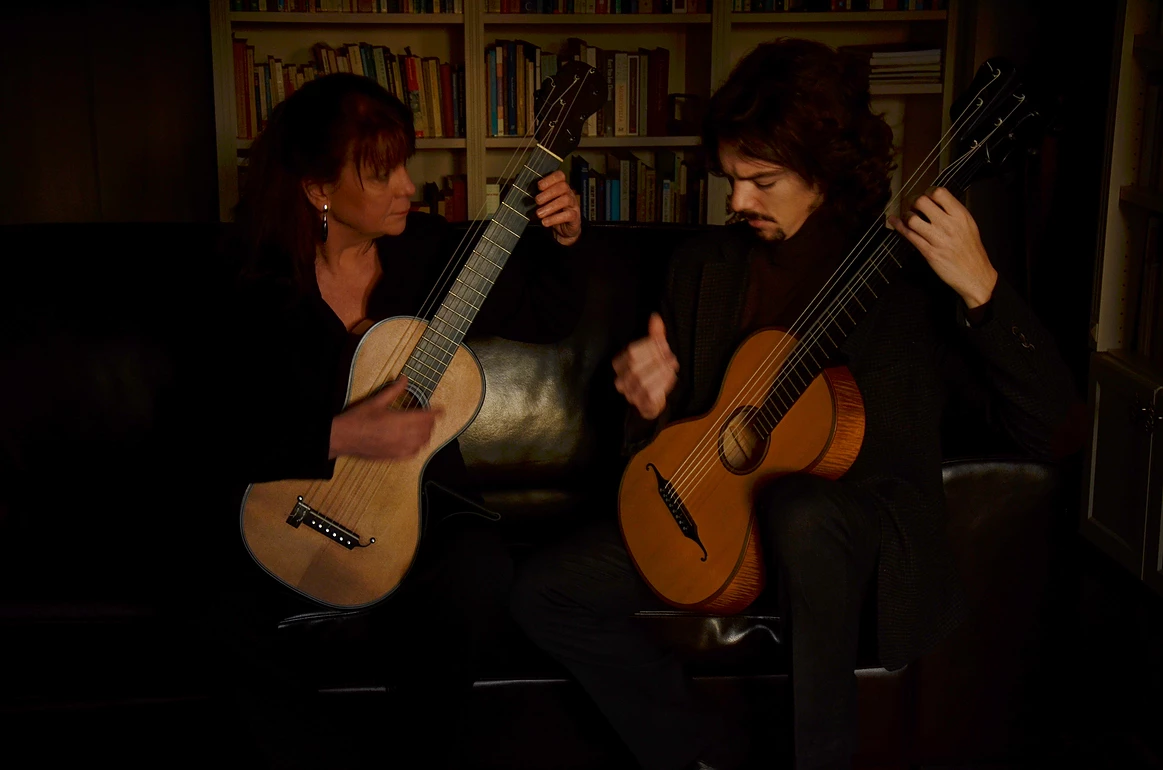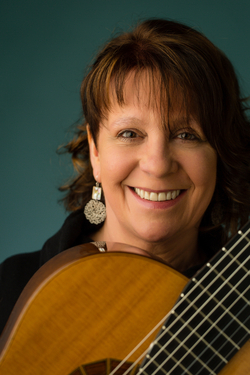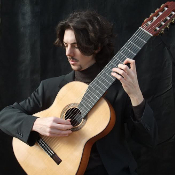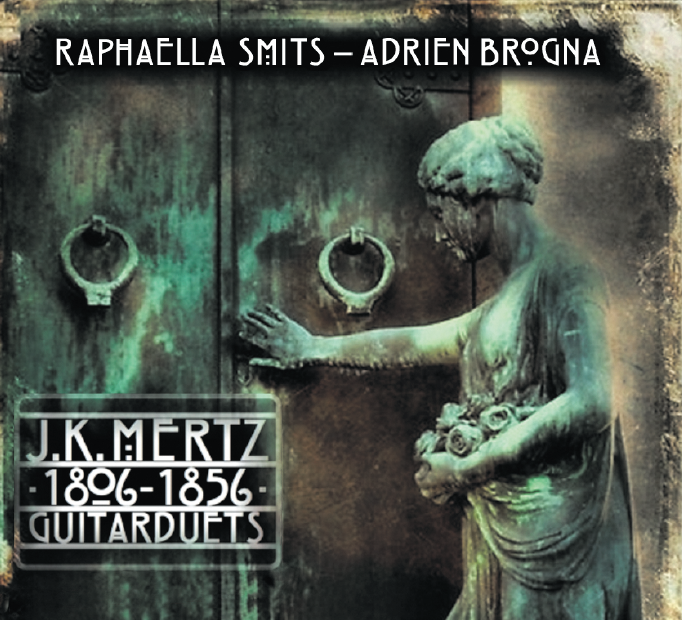
Fine Classical, Instrumental, and Specialty Recordings
Label: Soundset Recordings Item Number: SR1060 Format: CD Year Recorded: 2014 J.K. Mertz, 1806-1856: Guitar Duets Smits-Brogna Duo Raphaella Smits - guitar Adrien Brogna - guitar
Smits-Brogna Duo  The guitar duo Raphaella Smits and Adrien Brogna make a unique combination: both play on Romantic 8-string guitars and terz guitars. Here, they present their first duo CD with music by Johann Kaspar Mertz (1806-1857). Raphaella Smits - guitar  Raphaella Smits plays worldwide in her unique way on eight-string guitars and historical instruments. Recognized as ‘an uncommonly musical guitarist’ (Tim Page, New York Times), she always commits to the soul of the music. Her solo recitals as well as her performances with the most distinguished colleagues always meet enthusiastic audiences and press. Besides stage-work Raphaella Smits has made 21 recordings, many of them being listed as indispensable to refined music lovers. Raphaella Smits is internationally praised as an inspiring teacher for both guitar and chamber music. In addition to her chair at the Lemmens Institute in Belgium, she regularly gives master-classes in West and East Europe, in North and South America and in Japan. Organizers of international music competitions ask Raphaella as a member or as president of the jury because of her ability to listen and to judge so accurately. Here again she shows her talent to combine professional skills with a great sense of empathy. Raphaella studied classical music at the Royal Conservatories of Antwerp and Brussels. She also went to José Tomàs to perfect her playing at the "Catedra Andrès Segovia" in Spain. At that time she was giving her first recitals and became a persuasive advocate of the eight-string guitar. In 1986 Raphaella Smits was the first woman to win the first prize of the "XX Certamen Internacional de Guitarra Francisco Tarrega", the famous international guitar competition in Benicasim, Spain. That victory confirmed the progress of a successful career, which over the previous years had included prizes in the Granada and Palma de Mallorca contests. Chairmen Andrès Segovia and Narciso Yepes, both expressed their admiration for Raphaella's musicality and put prophetically confidence in her future achievements. Today Raphaella Smits is called quite rightly ‘une Grande Musicienne’ and ‘one of the most delicate and most cultivated performers of our time’ (Jean Bernard, Diapason, FR). Adrien Brogna - guitar  Born in 1985, Adrien Brogna is one of the most talented Belgian guitarists of his generation. Diligent and enthusiastic student since his childhood, he started learning the guitar with Yves Carlin then followed his superior course at the Royal Conservatory of Mons (Belgium) under the tutelage of Odair Assad, where he graduated in 2008 with Great Distinction. Noted for the sensitivity of his playing and his rhythmic fire, multifaceted guitarist now divides his time between a career of soloist, chamber musician and teacher. Talented recognized by his peers, he was only 22 years old when he was chosen to accompany the American soprano Dawn Upshaw at the Festival de Saint-Denis. There followed a tour in the United States via the Benaroya Hall in Seattle, England, Scotland, Greece - at the prestigious Pallas Theatre of Athens - and participation in the "Holland Festival" at the Muziek Gebouw aan 't ij Amsterdam. His solo appearances include a success in Argentina in the Festival Guitarras del Mundo. An astonishing duo of 8 strings Romantic guitars is born through his collaboration with Raphaella Smits and an album in 2014 recorded for Soundset Recordings label has allowed them a concert tour in the USA, Thailand, Germany, Belgium, France (Festival International de Guitare de Paris) and Slovakia (J.K.Mertz International Guitar Festival). The young guitarist is also a founding member of the Alki Guitar Trio whose two albums have been released by GHA RECORDS in 2011 and 2015. The trio has given concerts in Brazil, Germany, Belgium, France (Festival International de Guitare de Paris) and Poland (Silesian Guitar Festival). Adrien Brogna just released his first solo recording, a double album called "V" published by GHA RECORDS. A great honor to be on the catalogue of the label aside artists like Odair Assad, David Russell and Eduardo Isaac. Among his appearances with orchestra, Adrien Brogna played with the National Orchestra of Spain, the Saint Paul Chamber Orchestra, the Opera Royal de Wallonie and the Orchestre Royal de chambre de Wallonie. He worked under the direction of Miguel Harth-Bedoya, Augustin Dumay and Guy Van Waas. His repertoire has led him to collaborate with musicians such as percussionist Jamey Haddad, clarinetist David Krakauer, members of the Eighth Blackbird ensemble (USA) and the Brodsky Quartet (United Kingdom). His recordings are regularly broadcast on Belgian national radio Musiq3 and Klara and international radio stations. In addition to its specificities on the Romantic guitar, Adrien Brogna is a modern musician and his recent commitments make him open to music inspired by jazz in LUZ DA LUA, a duo with the Belgian bassist André Klenes. He also plays in a duet with bandoneonist Daniel Gruselle, in a program around tango music. Noticed pedagogue despite his young age, his teaching talents were solicited by big names. He was indeed Guest Professor at the Lemmens Instituut of Leuven assisting Raphaella Smits, he was assistant of Odair Assad at the Royal Conservatory of Mons and of Hughes Kolp at the Royal Conservatory of Liège. Adrien Brogna has the chance to be, since 2015, professor at the Royal Conservatory of Liège. He is also teacher at the Académie de musique de Quaregnon. Adrien Brogna is generously supported by the US strings company D'Addario. Johann Kaspar MERTZ (1806-1856) During the first decades of the 19th century Vienna was the world capital of music as well as a metropolis of the guitar. An excellent infrastructure with major music publishers (Diabelli, Artaria, Haslinger) and renowned instrument makers (including Johann Georg Stauffer and his son Johann Anton, Bernard Enzensperger, and Martin Stoss) attracted numerous musicians from the Habsburg crown lands, also from Italy (including the famous Mauro Giuliani and Luigi Legnani) to Vienna. The domesticity of the Biedermeier period was an ideal environment for the bourgeois music culture. In 1840, when JK Mertz (baptized Casparus Josephus Mertz, 1806-1856) arrived in Vienna coming from Pressburg (Bratislava), the Viennese guitar culture had already surpassed its peak. During the year of revolution, 1848, there were hardly any more concerts. Anton Stauffer closed his business and went to Prague. Mertz and his wife (the pianist Josephine Plantin) rarely ventured out, sat at home and composed waltzes. In order to avoid military service - this would have further affected his health already severely impaired by a previously suffered strychnine poisoning - he fled to Brno and did not return until four weeks after the political situation had improved. An important source of income - private lessons mainly in aristocratic circles - had almost dried up after the revolution of 1848. In this time of crisis he created his guitar duets (‘Ich denke dein’ is dated May 28, 1850) and other chamber music works. Previously Mertz had only composed solo pieces and published only the easiest and the medium difficult ones (‘Bardenklänge’, ‘Ländler’, ‘Opernrevue’). The big concert pieces for eight and ten string guitar like \'Harmonie du Soir’, ‘Pensée fugitive\' and \'Elegy\' exist only in manuscript, just as the duets. To Nikolai Petrovich Makarov (1810-1890), a wealthy Russian virtuoso who had visited all the prominent guitarists of his time in 1850, Mertz explained this fact as follows: \"... as long as these compositions remain in my briefcase, they remain new; and are mine for my own concerts they would become distorted and mutilated by those miserable guitarists who can only scratch the strings of the guitar.\" (from Guitar Review 1947). There is no evidence of public performances of the duets, they might have been written for educational purposes. According to Makarov the compositions of J. K. Mertz have \"rich composition, great musical knowledge, excellent development of an idea, unity, novelty, grandeur of style, absence of trivial expression and multiplicity of harmonic effects“. Apart from a few works by Napoleon Coste and Giulio Regondi, Mertz \'music is the only truly romantic in the 19th century guitar repertory. Most guitar composers were very conservative in terms of style. Thanks to his wife Mertz was well acquainted with the contemporary piano literature (Mendelssohn, Schumann, Chopin) and also musically influenced by it. In the guitar duos this influence is mainly reflected in expressive tone paintings, such as the death bells in ‘Am Grabe der Geliebten’ or the gentle swell of water in ‘Wasserfahrt am Traunsee’. Caused by the different registers of terz guitar and standard tuning the roles of melody and accompaniment merge into a totally new sound pattern. The terz guitar is an instrument with a shorter scale length (55-57 cm), tuned G c f b d\' g\', and plays a major role in the Viennese chamber music with guitar, comparable to the first violin in string ensembles. The capo on the third fret is often mentioned already around 1810 by Leonard de Call, Anton Diabelli and Mauro Giuliani, but after 1815 “Terzguitarre” becomes a generally used term. Obviously a guitar in this pitch and tonality was the best choice in combination with flute, piano and string instruments, so that one of the above guitarists or luthiers came up with the idea to build guitars in this pitch. The earliest known terz guitars, both from 1814, were made by Johann Rudert and Jakob Krasny (Stauffer did not date his instruments in this period). Giuliani wrote his third guitar concerto (op. 70) for terz guitar and later he adopted also the second (op. 36). In most guitar duets of Viennese origin the first part is performed by a terz guitar. Text by Dr. Stefan Hackl The instruments on the CD * Terz guitar (Bernard Enzensperger, Vienna, 1850, Collection Brigitte Zaczek): Bernard Enzensperger (1788-1865) comes from Füssen, a small town in Southern Germany, a metropolis of lute making since the 16th century. He was a student of Georg Thir and apprentice of Georg Stauffer in Vienna. With his perfectly shaped and sonorous superior instruments and with his innovations such as the shield-shaped “Akustik-Guitarre “ with tags for finding the harmonics, Enzensperger noticeably stepped out of the shadow of Stauffer and became one of the main instrument builders of his time. (=Git1 in tracks: 1, 4, 5, 6, 7, 8, 10) * Guitar Mirecourt (Anonymous, 1827, restored by Bernhard Kresse, Collection Raphaella Smits): Mirecourt was the center of the French instrument making in the 19th century. Masters such as Charles Joseph Marchal, François Roudhloff and Bruno Petitjean, produced guitars in their workshops, always consistent in quantity and quality. This original six-string guitar was later converted for seven or eight strings as required by the music of Coste, Mertz and Legnani. (=Git2 in tracks: 2, 3, 9, 11, 12, 13) * Terz guitar (labeled \"k.k.l.p. Musik-Instrumenten-Fabriks-Niederlage des Franz Hoyer in Wien\", 1840, Collection Alex Timmerman): The Bohemian Egerland (the trading company Hoyer comes from Schönbach) and the adjacent German Vogtland were centers of musical instrument manufactury similar to Mirecourt in France. The instruments made there were rarely signed and usually bore the label of the merchant. The “Wiener Modell” (such as this instrument in Stauffer style) was produced well into the 20th century. (=Git1 in tracks: 2, 3, 9, 11, 12, 13) * Eight-string guitar by Bernhard Kresse (Cologne, 2010): The guitar is inspired by Stauffer’s Legnani model, extended with two free-floating bass strings. By 1840, the musical newspaper ‘Allgemeine Wiener Musik Zeitung’ reported of a new model with eight strings that Stauffer had built for Luigi Legnani and Giulio Regondi. Also Mertz played such a guitar, as shown in a concert report from Brno, September 23, 1841. (=Git2 in tracks: 1, 4, 5, 6, 7, 8, 10) Literature: * Hackl, Stefan: Die Gitarre in Osterreich. Studienverlag, Innsbruck/Wien/Bozen 2011. * Hofmann, Erik Pierre, Hackl, Stefan und Mougin, Pascal: Stauffer & Co. Die Wiener Gitarre des 19. Jahrhunderts. Editions Les Robins, Germolles sur Grosne 2012. * Makarov, Nikolai Petrovich: Zadushevnaia Ispo’ved; (Heartfelt Confession), St. Petersburgh 1859. Translation: Vladimir Bobri and Nura Ulreich, Guitar Review no. 3 (1947). * Stempnik, Astrid: Caspar Joseph Mertz: Leben und Werk des letzten Gitarristen im osterreichischen Biedermeier: Eine Studie über den Niedergang der Gitarre in Wien um 1850. Peter Lang, Frankfurt/Bern/New York/Paris 1990.
Label: Soundset Recordings Item Number: SR1060 Format: CD Year Recorded: 2014 The guitar duo Raphaella Smits and Adrien Brogna make a unique combination: both play on Romantic 8-string guitars and terz guitars. Here, they present their first duo CD with music by Johann Kaspar Mertz (1806-1857). “An unforgettable concert, total symbiosis. First class!!” Guy De Mey, tenor. “A delicate musical dialogue: what a treat, from beginning to end.” Ray Verhaeghe, actor. “An absolutely marvelous performance presented with high precision and subtle poetry.” Bernhard Kresse, luthier. "Moi je l'ai écouté toute la journée à l'atelier, c'est un programme de musique bien connu (à part deux pièces) et pourtant c'est comme si ces pièces étaient redécouvertes, interprétées avec beaucoup de vécu et de sérénité; les tempi sont très bien choisis, le dialogue des guitares est passionnant (je crois que ça doit beaucoup aux Terz-Gitarren), le respect des musiciens pour la musique imaginée par J.K. Mertz et pour la manière de s'exprimer de son alter ego dans le duo est manifestement au coeur de la réussite de ce disque, intense et sobre. Chacun des musiciens est expressif, je n'ai cherché à deviner qui jouait quoi, et le lyrisme est contenu par le souci d'être cohérent en chantant à deux. Mon meilleur disque de guitare depuis longtemps; en plus c'est un cadeau!" PMR, Anselmus Albini Alumnus. Please click on "Files" to see scans of more reviews from publications. | 
Physical CD $16.99 US MP3 Album $10.00
| ||||||||||||||||||||||||||||||||||||||||||||||||||||||||||||||||||||||||||||||||||||||||||||||||||||||||
 Follow Us on Twitter
Follow Us on Twitter Follow Us on Instagram
Follow Us on Instagram Visit Our Partner Soundset Recordings
Visit Our Partner Soundset Recordings